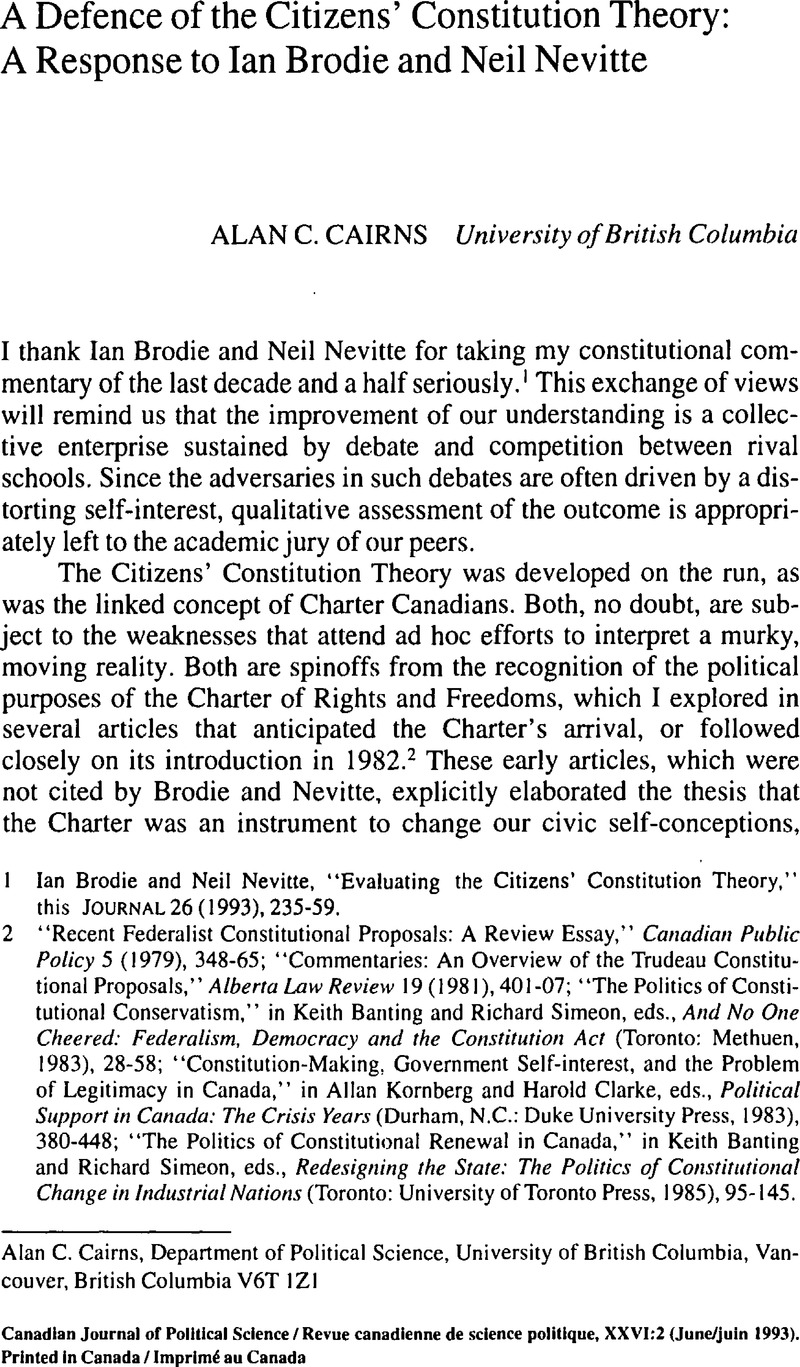Published online by Cambridge University Press: 10 November 2009

1 Brodie, Ian and Nevitte, Neil, “Evaluating the Citizens' Constitution Theory,” this Journal 26 (1993), 235–59.Google Scholar
2 “Recent Federalist Constitutional Proposals: A Review Essay,” Canadian Public Policy 5 (1979), 348–65Google Scholar; “Commentaries: An Overview of the Trudeau Constitutional Proposals,” Alberta Law Review 19 (1981), 401–07Google Scholar; “The Politics of Constitutional Conservatism,” in Banting, Keith and Simeon, Richard, eds., And No One Cheered: Federalism, Democracy and the Constitution Act (Toronto: Methuen, 1983), 28–58Google Scholar; “Constitution-Making, Government Self-interest, and the Problem of Legitimacy in Canada,” in Kornberg, Allan and Clarke, Harold, eds., Political Support in Canada: The Crisis Years (Durham, N.C.: Duke University Press, 1983), 380–448Google Scholar; “The Politics of Constitutional Renewal in Canada,” in Banting, Keith and Simeon, Richard, eds., Redesigning the State: The Politics of Constitutional Change in Industrial Nations (Toronto: University of Toronto Press, 1985), 95–145.CrossRefGoogle Scholar
3 Morton, F. L., Morgentaler v. Borowski: Abortion, the Charter and the Courts (Toronto: McClelland and Stewart, 1992), 111.Google Scholar
4 Ibid., 116.
5 According to Romanow, White and Leeson: “Nothing in the whole episode of constitutional transformation between 1978 and 1982 was as visible as the creation of the Charter of Rights and Freedoms… Of all the justifications for constitutional reform … none were [sic] as responsive to widely shared anxieties as the proposal to entrench in the Constitution a list of fundamental rights” (Romanow, Roy, Whyte, John and Leeson, Howard, Canada… Notwithstanding: The Making of the Constitution 1976–1982 [Toronto: Carswell/Methuen, 1984], 216, 218).Google Scholar
6 As Lynn MacDonald, 1981 president of the National Action Committee on the Status of Women, stated: “Having equality rights in the Charter was never an issue [for women's groups]. It became an issue because the government announced there was going to be a Charter.” Doris Anderson, then president of the Canadian Advisory Council on the Status of Women, agreed, stating: “women were quite disinterested [sic] in the whole idea of the constitution.” Cited in Sandra Burt, “What's Fair? Changing Feminist Perceptions of Justice in English Canada,” mimeograph, originally presented as the 1991 Access to Justice Lecture at the Faculty of Law, University of Windsor, November 1991, 13; emphasis in original.
7 See Cairns, Alan, “Reflections on the Political Purposes of the Charter: The First Decade,” in Beaudoin, Gerald-A., ed., The Charter: Ten Years Later (Cowansville, Quebec: Les Éditions Yvon Blais, 1992), esp. 175–91.Google Scholar